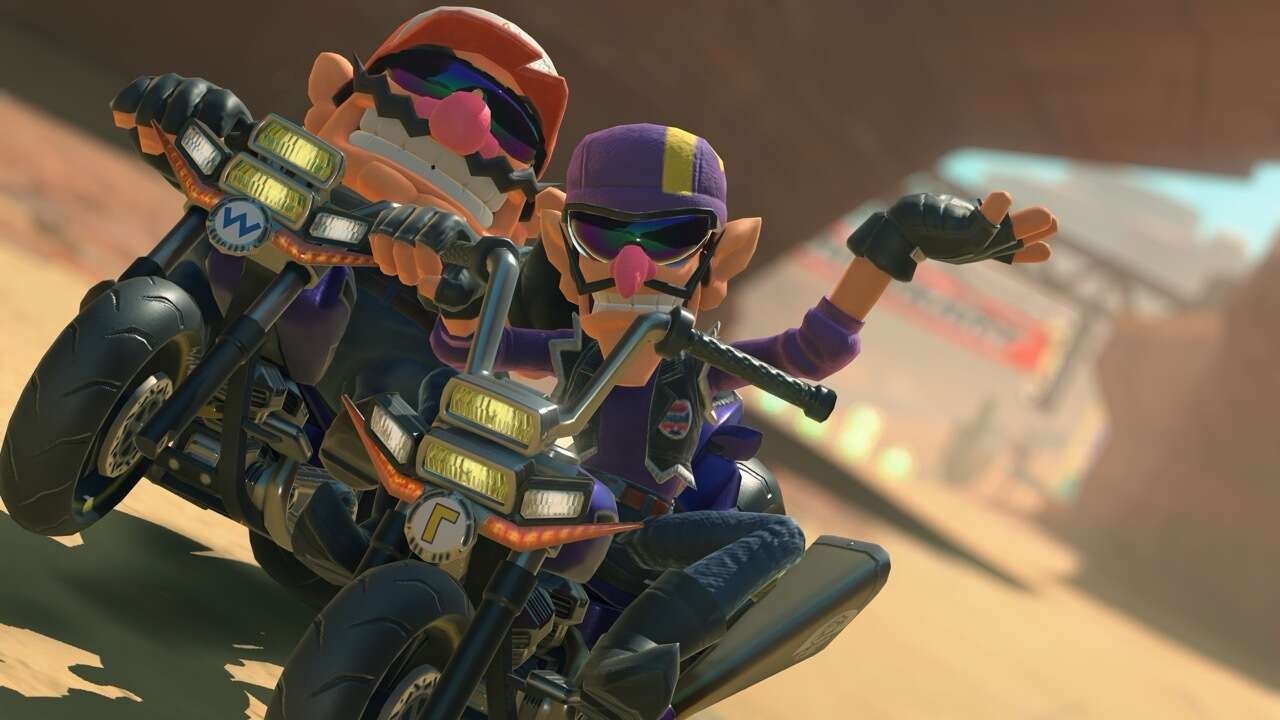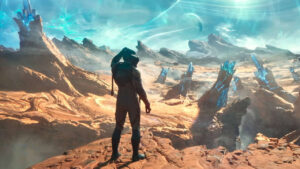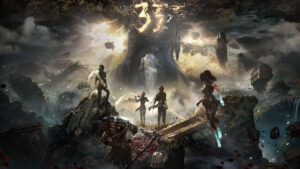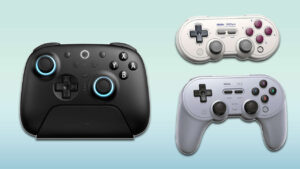Nintendo seemed slow to react to the evergreen status of Mario Kart 8 Deluxe, a humble Switch port of a Wii U game that surpassed all expectations by becoming the top-selling game on one of its most successful platforms. Mario Kart World, the banner game for the launch of the Switch 2, carries with it the expectation that of course this will be one of the games most associated with the system for its entire lifespan. The challenge was crafting a new game that felt sufficiently suited to carry those expectations. Due to its blend of skillful mechanical tweaks, lovely aesthetics, and a general design philosophy built around delightful surprises, this one will go the distance.
The biggest standout feature of Mario Kart World–the one that its name, identity, and many of its mechanics revolve around–is the world itself. For the first time in the series history the races aren’t built as standalone tracks, but rather as part of a large contiguous map. Iconic locations like Bowser’s Castle or Moo Moo Meadows are physical locations connected to each other through a series of highways and byways. The Grand Prix cups, the ostensible story campaign of a Mario Kart game, are just routes through this world the same way a real street race will block off a specific route.
Within that context, though, the races themselves are more dynamic than ever. Nintendo has started licensing its properties out for theme park attractions since the release of the last Mario Kart, and it’s hard not to notice the roller coaster-like approach to these tracks. Like a well-designed ride, you’re consistently confronted with surprises and obstacles that keep things visually interesting and mechanically exciting. A race along the savannah will feature adorably plump animals like a herd of zebra, while a desert area surprises you with the Easter Island-like Tokotoko enemies from Super Mario Land, and another track may fling you into the air or have you navigate choppy waters. It’s a treat for longtime Nintendo fans, especially, as the wealth of references goes much deeper than it has before.
Gallery
That goes doubly for the character selection. After venturing outside of the Mushroom Kingdom with inclusions like Link and Isabella in Mario Kart 8, Mario Kart World sticks strictly inside the confines of Mario–and then expands its scope exponentially. You have series regulars like Mario, Bowser, and Toad alongside such random pulls as Swoop the bat, Para-Biddybud the insect, and the frog-like Coin Coffer. And of course there’s Cow, already a breakout star of the game’s promotion, who seems to tickle players with her very presence.
Then on top of that, the core Mario characters all have a variety of costume changes to unlock. Grab a sacked “Dash Snack” lunch as Toad and he may don a racing helmet modeled after his iconic mushroom head, or presto-chango into a train engineer. Alongside the variety of surprises on the tracks and the massively expanded roster, the impressive volume of costumes is just another way that Mario Kart World aims to constantly surprise you.
The methods of unlocking characters and costumes can be a little patchwork, and Mario Kart World seems intentionally opaque about exactly how it works. You might pick up the same costume several times in a row through Dash Snacks, and then find a new character or costume unlocked when someone uses a Magikoopa item. I’m sure completionists rushing to get a full roster complete with all of the associated costumes may find this frustrating or work to unlock the exact rhyme and reason, but I’m rather enjoying taking the game on its own terms. It’s aimed at long-term play, wishing to dole these out seemingly randomly and slowly, and I’m happy to let it do so. The less-engaging collectibles are stickers, which you receive for completing various in-game challenges. Those serve as the kart customization for Mario Kart World, which is less robust than the mix-and-match kart creation of Mario Kart 8 Deluxe, especially since you can only equip one at a time.

I am mildly disappointed that much of the expanded roster doesn’t get its own costume changes. It makes the creature characters feel like they’re B-tier, and actually dissuades me from playing as them when I know there are more costumes to unlock if I pick someone from the core cast. I would love to be racing as Para-Biddybud more, but it just feels like I’m missing out if I do. By that same token, though, this unlock system does encourage me to play as characters I ordinarily wouldn’t. I’ve never been a fan of heavier characters, but I’m actually taking the time to play more as Wario or Bowser because I want to unlock all of their fashionable duds.
All of this is especially appealing because Mario Kart World looks gorgeous and serves as a nice showpiece for the increased power of the Switch 2. Nintendo excels at art direction, to the point that even older games like Mario Kart 8 Deluxe have a playful animated look that still doesn’t feel dated. But Mario Kart World shows what Nintendo can do with both its knack for visual flair and increased horsepower, and the result is stunning. It’s a living cartoon, complete with lovely little touches like facial expressions that you’ll never even see unless you venture into Photo Mode.
The entire world being connected means that courses bleed into each other, which I find mostly amusing and only occasionally distracting. Sometimes when you’re racing from one track to another in the middle of a Grand Prix, a stage will start with a completely different visual style than it finishes with. It’s a neat way to see the transition, but I do sometimes miss when a course would have its very own visual language and identity that’s distinct from anything else.
Rainbow Road, the ultimate conclusion of the Grand Prix campaign, is the sole example of a standalone course that’s disconnected from the world, and it stands apart from the rest due to it. Mario Kart has offered lots of different Rainbow Roads, but this one may be my new favorite of all time. It’s a sprawling triumph–a visual feast, a playful celebration of the sights and sounds of the game up to that point, and an incredibly diverse and lengthy marathon of a race on its own.


Naturally, it wouldn’t be a new Mario Kart without giving you new tools and skills to master. The series has always excelled at having a low skill floor and a high skill ceiling. Anyone can pick up a game of Mario Kart World, but real karting pros can show off like never before. There are new items to master like the Feather and Hammer alongside old favorites. MKW makes a subtle change by automatically dragging certain items like Green Shells behind you, rather than letting you drag them on command, which both gives newer players one less thing to track, and increases the risk of losing an item if you’re targeted by a Blue Shell or Lightning Bolt.
The biggest new skill to master, though, is the Charge Jump. It essentially gives veterans a new tool to use on straightaways, charging up like they would with a power-slide on a turn. The jump is smaller than a ramp or Feather, but big enough to dodge an attack or hop over an obstacle if you time it just right. It also pairs well with the new stunting system, which lets you grind on rails and cruise off walls, which also gives you a speed boost. The off-road aspect also sometimes means you go into the water, where it transitions automatically to an aquatic vehicle and handles with choppy wave mechanics that give me fond memories of Wave Race.
And crucially, Nintendo has taken this new suite of mechanics and level of polish and applied it to a blend of modes and methods of play that offer more ways to kart than in the series’ long history. You can still take on Grand Prix, VS, and time trials like always, and the newly revised Battle Mode no longer feels like an afterthought. The arenas for Battle are familiar locales from the map like always, but roped off as closed loops to force confrontations. It’s a much more aggressive style of play, and little stunts like a quick-180 reward high-level play.
Then there’s the highlight of the new additions–Knockout Tour. The presence of a single contiguous world means that you can draw long routes throughout it, serving as the basis of Knockout Tour. The new mode takes full advantage of the larger 24-player count by slowly winnowing down the players across each checkpoint, which creates some naturally tense moments as you continuously fight to qualify for the next round. It feels like the ideal middle-ground for a session–not so insubstantial as a quick VS race, but not the time commitment of a Grand Prix.


Knockout Tour is an especially great showcase for the increased player count in online multiplayer. While I found the 24-player aspect a bit insubstantial in single-player–the last dozen or so racers trailed far enough behind that they didn’t really matter–playing with a full horde of players online is a totally different experience. It makes the classic kart racer into a raucously chaotic party game. Even with track sizes and item distribution seemingly tuned to fit the greater player count, against other humans you’re bound to bump shoulders with them often, and that seems by design.
The increased player count for online does mean you can sit waiting for a full match for quite a while. It’s nice that the game lets you free roam while you wait for the matchmaking to complete, but the wait times have been inconsistent. Sometimes it’s snappy and quick; other times I’m roaming for several minutes waiting for a full lobby. So far it seems as if searching for a regular race takes significantly longer than a Knockout Tour, but your mileage may vary. It is nice, though, that once matched with other players for a race you remain grouped with them voting for the next race, rather than needing to search all over again.
Speaking of free roaming, you can do it at any time through the main menu, not just as a lobby waiting room. Nintendo seems to have envisioned this mostly as a way to meet up with friends and cruise around, but the open-world aspect feels sparse. There are things to do exclusive to the free roaming mode, like driving into an 18-wheeler and taking over it for a short time. There are also P-Switch challenges that give you a quick task to complete, like reaching a high vantage point or avoiding falling boulders to reach a goal line. These are nice little diversions, but the prizes for completing them–even more stickers–ultimately feel pretty insubstantial.
Nearly nothing else does, though. Mario Kart World is a massive, sprawling sequel that playfully expands and iterates on the qualities that made Mario Kart 8 Deluxe such an enduring success. It’s an incredibly fun and rewarding kart racing experience that’s easy to understand, with enough mechanical nuance to reward veteran kart racers, all presented beautifully as a Switch 2 showpiece. It will be shocking if this game doesn’t enjoy the same long-term success of its predecessor, because it’s among the best in the series and a worthy marquee title for the launch of a new Nintendo console.









